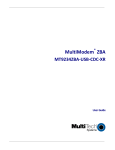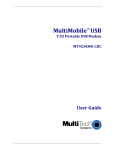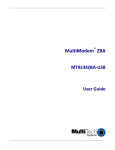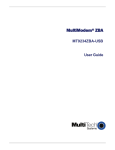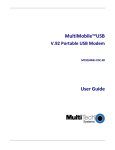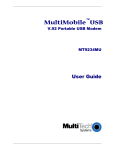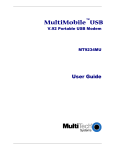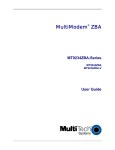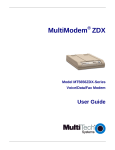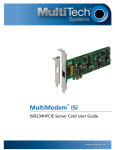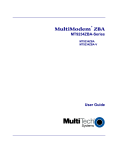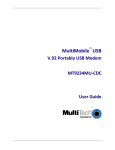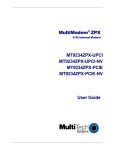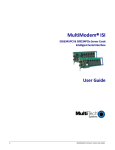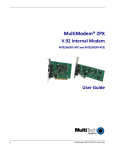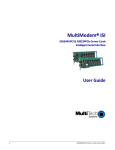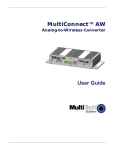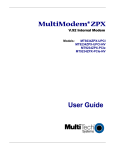Download Multitech MultiModem ZBA MT9234ZBA?V Specifications
Transcript
® MultiModem ZBA MT9234ZBA‐USB‐CDC User Guide MultiModem ZBA User Guide MT9234ZBA‐USB‐CDC S000473B Revision B Copyright All rights reserved. This publication may not be reproduced, in whole or in part, without prior expressed written permission from Multi‐Tech Systems, Inc. Copyright © 2012 by Multi‐Tech Systems, Inc. Multi‐Tech Systems, Inc. makes no representations or warranties with respect to the contents hereof and specifically disclaims any implied warranties of merchantability or fitness for any particular purpose. Furthermore, Multi‐Tech Systems, Inc. reserves the right to revise this publication and to make changes in the content hereof without obligation of Multi‐Tech Systems, Inc. to notify any person or organization of such revisions or changes. Check Multi‐Tech’s Web site for current versions of our product documentation. Record of Revisions Revision A B Date 03/04/10 01/12/12 Description Initial release of MT9234ZBA‐USB‐CDC. Removed references to product CD. Trademarks MultiModem, Multi‐Tech, and the Multi‐Tech logo are registered trademarks of Multi‐Tech Systems, Inc. Windows is a registered trademark of Microsoft Corporation in the United States and/or other countries. Other trademarks and trade names mentioned in this publication belong to their respective owners. Patents This device is covered by one or more of the following patents: 6,031,867; 6,012,113; 6,009,082; 5,905,794; 5,864,560; 5,815,567; 5,815,503; 5,812,534; 5,809,068; 5,790,532; 5,764,628; 5,764,627; 5,754,589; D394,250; 5,724,356; 5,673,268; 5,673,257; 5,644,594; 5,628,030; 5,619,508; 5,617,423; 5,600,649; 5,592,586; 5,577,041; 5,574,725; D374,222; 5,559,793; 5,546,448; 5,546,395; 5,535,204; 5,500,859; 5,471,470; 5,463,616; 5,453,986; 5,452,289; 5,450,425; D361,764; D355,658; D355,653; D353,598; D353,144; 5,355,365; 5,309,562; 5,301,274;7082106;7082141;7092406 . Other patents pending. World Headquarters Multi‐Tech Systems, Inc. 2205 Woodale Drive, Mounds View, Minnesota 55112 Phone: 763‐785‐3500 or 800‐328‐9717 Fax: 763‐785‐9874 www.multitech.com Contacting Multi‐Tech Support Online Support Portal: https://support.multitech.com In order to better serve our customers, manage support requests and shorten resolution times, we have created the online web portal allowing you to submit questions regarding Multi‐Tech products directly to our technical support team. Get answers to your most complex questions, ranging from implementation, troubleshooting, product configuration, firmware upgrades and much more. To create an account and submit a Support Case on the Portal, visit https://support.multitech.com. Knowledge Base and Support Services: www.multitech.com/support.go The Knowledge Base provides immediate answers to your questions and gives you access to support resolutions for all Multi‐Tech products. Visit our support area on the website for other support services. Technical Support U.S. office hours are 9am – 5pm, CST Country Europe, Middle East, Africa: U.S., Canada, all others: By Email [email protected] [email protected] By Phone (44) 118 959 7774 (800) 972‐2439 or (763) 717‐5863 Warranty You can find warranty information at: http://www.multitech.com/warranty.go MT9234ZBA‐USB User Guide 2 Contents Chapter 1 – Product Overview ..................................................................................................................... 5 Feature Overview .................................................................................................................................................... 5 Package Contents ................................................................................................................................................... 5 Other Documentation.................................................................................................................................................... 5 Technical Specifications ........................................................................................................................................ 6 Chapter 2 – Installing the Modem ................................................................................................................ 7 Safety Warning Telecom ........................................................................................................................................ 7 Connecting the Modem to Your PC ...................................................................................................................... 7 Connecting the USB ..................................................................................................................................................... 7 Connecting the Line ...................................................................................................................................................... 8 Connecting a Phone ..................................................................................................................................................... 8 Installing the Modem Driver ................................................................................................................................... 9 Manually Installing the MT9234ZBA-USB-CDC in Windows 7 .............................................................................. 9 Installing the Modem Driver for use with Windows Vista ...................................................................................... 13 Installing the Modem in Windows Server 2008, 2003 and XP ............................................................................. 14 Configuring the Country Where Modem is Used ............................................................................................... 18 Using the Global Wizard to Configure Your Modem .............................................................................................. 18 Using AT Commands to Configure Your Modem ................................................................................................... 18 Chapter 3 – Operating the Modem ............................................................................................................. 19 Front Panel Overview ............................................................................................................................................ 19 Connecting to the Internet .................................................................................................................................... 19 Setting Up Remote-Node Client Program ............................................................................................................... 19 Chapter 4 – Remotely Configuring the Modem ........................................................................................ 20 Remotely Configuring the Modem ....................................................................................................................... 20 Changing Default Passwords and Escape Character ....................................................................................... 20 Changing the Setup Password .................................................................................................................................. 20 Changing the Remote Escape Character ................................................................................................................ 20 Chapter 5 – Troubleshooting ...................................................................................................................... 21 None of the Indicators Light ....................................................................................................................................... 21 The Modem Does Not Respond to Commands ...................................................................................................... 21 The Modem Cannot Connect When Answering ..................................................................................................... 21 The Modem Doesn’t Work with Caller ID ................................................................................................................ 22 Fax and Data Software Can’t Run at the Same Time ........................................................................................... 22 The Modem Dials But Cannot Connect ................................................................................................................... 22 The Modem Disconnects While Online .................................................................................................................... 23 3 MT9234ZBA‐USB User Guide Contents Appendix A – Regulatory Compliance ....................................................................................................... 24 FCC Part 68 Telecom ............................................................................................................................................. 24 FCC Part 15 Regulation ......................................................................................................................................... 25 Canadian Limitations Notice ................................................................................................................................ 25 Industry Canada ..................................................................................................................................................... 25 International Modem Restrictions ........................................................................................................................ 27 EMC, Safety, and R&TTE Directive ......................................................................................................................... 27 Thailand Approval ....................................................................................................................................................... 27 South African Notice ................................................................................................................................................... 27 Restriction of the Use of Hazardous Substances (RoHS) .................................................................................... 28 REACH Statement ...................................................................................................................................................... 28 Appendix B – Waste Electrical and Electronic Equipment ..................................................................... 29 Appendix C - C-ROHS HT/TS Substance Concentration ........................................................................ 30 Appendix D – ASCII Conversion ................................................................................................................. 31 Index ................................................................................................................................................................ 33 MT9234ZBA‐USB User Guide 4 Chapter 1 – Product Overview Thank you for using the MultiModem ZBA‐USB modem. Your MultiModem product data/fax modem supports remote configuration and dial‐up connections. It offers V.34/33.6K fax and Error Correction Mode that reduces fax transmission time by more than half when compared to traditional fax modems. In addition, these modems are globally approved for use in many countries around the world. Feature Overview ● V.92/56K download speeds and 48K upload speeds when connecting with V.92 servers ● V.44 compression improves data throughput rates ● Class 1.0 and Class 2.1 faxing at speeds to V.34/33.6K bps (Super G3) ● Error Correction Mode (ECM) provides fast and reliable fax transmissions ● Windows Plug‐and‐Play operation ● Linux compatible ● U.S. Caller ID reporting ● Remote configuration for centralized setup and control ● Globally approved models for use in many countries worldwide ● Small footprint and stackable design ● Self‐resetting lightning protection ● Flash memory for easy updates ● USB cable included ● Two‐year warranty Package Contents The MultiModem USB package contains: ● A MultiModem data/fax modem ● A set of four self‐adhesive plastic feet ● One USB cable ● One modular telephone cable Other Documentation The AT Commands for the MultiModem are described in a separate reference guide. You can find this guide on the Multi‐Tech website. 5 MT9234ZBA‐USB User Guide Chapter 1 – Product Overview Technical Specifications Your MultiModem ZBA‐USB‐CDC modem has the following specifications. Trade Name Model Number Server‐to‐Client Data Rates Client‐to‐Server Data Rates Client‐to‐Client Data Rates Fax Data Rates Modem Compatibility Fax Compatibility Error Correction Data Compression Flow Control Intelligent Features Command Buffer Transmit Level Frequency Stability Receiver Sensitivity AGC Dynamic Range Connectors Cables Diagnostics Environmental Dimensions Weight Power Limited Warranty MT9234ZBA‐USB User Guide MultiModem® ZBA MT9234ZBA‐USB V.90 speeds when accessing a V.90 or V.92 server (actual speed depends on server capabilities and line conditions) Up to 50Kbps when accessing a V.92 server (actual speed depends on server capabilities and line conditions); otherwise, the same as client‐to client data lines. 33600, 31200, 28800, 26400, 24000, 21600, 19200, 16800, 14400, 12000, 9600, 7200, 4800, 2400, 1200, 0‐300 bps 33600, 31200, 28800, 26400, 24000, 21600, 19200, 16800, 14400, 12000, 9600, 7200, 4800, 2400, 1200, 0‐300 bps ITU‐T V.92, V.90, V.34 enhanced, V.34, V.34bis, V.32, V.32bis, V.22; Bell 212A and 103; ITU‐T V.21, V.42, V.42bis, V.44 ITU‐T “Super” Group 3, Class 1.0, 2.0, 2.1, T.4, T.30, V.21, V.27ter, V.29, V.34, V.17; TIA/EIA 578 Class 1, 2, TR29.2 ITU‐T V.42 ITU‐T V.44 (4:1 throughput), V.42bis (4:1 throughput), MNP 5 (2:1 throughput) XON/XOFF (software), RTS/CTS (hardware) Plug and play; fully AT command compatible; autodial, redial, repeat dial; pulse or tone dial; dial pauses; auto answer; caller ID; EIA extended automode; adaptive line probing; automatic symbol and carrier frequency during start‐up, retrain, and rate renegotiation; DTMF detection; call status display, auto‐parity and data rate selections; keyboard‐ controlled modem options; non‐volatile memory; on‐screen displays for modem option parameters; command lines of up to 40 characters each; remote configuration 40 characters ‐12 dBm (Euro/NAM) – varies by country/region setting ±0.01% ‐43 dBm under worst‐case conditions 43 dB USB connector; two RJ‐11 phone jacks One RJ11 phone cable One USB cable Note: To reduce interference, shield cables connected to the computer. Power‐on self test, local analog loop, local digital loop, remote digital loop. Temperature range 0°– 50° C (32°–120° F); humidity range 20–90% (non‐condensing) 10.9 cm wide x 14.5 cm long x 2.5 cm high (4.3” x 5.7” x 1.10”) 227 g (8 oz) Typical Maximum Measured Volts 4.96 4.94 Current (AMPS) 0.136 0.176 Watts 0.675 0.869 2 year 6 Chapter 2 – Installing the Modem This chapter describes how to set up your Multi‐Tech MultiModem product. Safety Warning Telecom ● Use this product only with UL and cUL listed computers. ● To reduce the risk of fire, use only 26 AWG (.41 mm) or larger telephone wiring. ● Never install telephone wiring during a lightning storm. ● Never install a telephone jack in wet locations unless the jack is specifically designed for wet locations. ● Never touch uninsulated telephone wires or terminals unless the telephone line has been disconnected at the network interface. ● Use caution when installing or modifying telephone lines. ● Avoid using a telephone during an electrical storm. There is a risk of electrical shock from lightning. ● Do not use a telephone in the vicinity of a gas leak. ● This product must be disconnected from the telephone network interface when servicing. Connecting the Modem to Your PC Placing the modem in a convenient location, connect it to your computer’s USB port, to the telephone line, and, optionally, to your telephone. Connecting the USB Plug one end of the USB cable into the USB connector on the modem, and the other end into a USB port connector on your computer. 7 MT9234ZBA‐USB User Guide Chapter 2 – Installing the Modem Connecting the Line Plug one end of the phone cable into the modem’s LINE jack and the other end into a phone line wall jack. Note: The LINE jack is not interchangeable with the PHONE jack. Do not plug the phone into the LINE jack or the line cable into the PHONE jack. Note: The Federal Communications Commission (FCC), and Industry Canada impose certain restrictions on equipment connected to public telephone systems. See Appendix A for more information. . Connecting a Phone For voice‐only calls, you can optionally plug a telephone into the modem’s PHONE jack. MT9234ZBA‐USB User Guide 8 Chapter 2 – Installing the Modem Installing the Modem Driver After the installation has been completed, you should test the operation of your new MT9234ZBA‐USB by registering it. Key in the URL given below and follow the on‐line instructions: http://www.multitech.com/en_US/TOOLS/Forms/register/warranty.asp Manually Installing the MT9234ZBAUSBCDC in Windows 7 After connecting your MT9234ZBA‐USB‐CDC to an available USB port, Windows 7 reports that the driver software was not successfully installed. Windows 7 no longer uses the new device wizard for installations. To manually point Windows 7 to the drivers needed: 1. Click the Windows Start button and select Control Panel from the options in the right‐hand pane. 2. Left‐click the Hardware and Sound link. 3. In the Devices and Printers group click Device Manager. 9 MT9234ZBA‐USB User Guide 4. Chapter 2 – Installing the Modem In the list of devices, find an item called MT9234ZBA‐USB‐CDC. Right‐click on this item and select Update Driver Software. 5. Left‐click the option Browse my computer for driver software. MT9234ZBA‐USB User Guide 10 Chapter 2 – Installing the Modem 6. Click Browse and navigate to the folder containing the appropriate drivers for your install (either 34‐bit or 64‐bit). Click OK. 7. 11 Click Next to continue the installation. MT9234ZBA‐USB User Guide Chapter 2 – Installing the Modem 8. A Windows Security window stating that the publisher cannot be verified might appear. If so, click Install this driver software anyway. 9. A transitory window opens as the installation completes. 10. To finish installing, click Close. 11. After installing, ensure the MT9234ZBA‐USB is working by registering it. To do so, go to the following website and follow the instructions there: http://www.multitech.com/en_US/TOOLS/Forms/register/warranty.asp MT9234ZBA‐USB User Guide 12 Chapter 2 – Installing the Modem Installing the Modem Driver for use with Windows Vista 1. Power up your computer. 2. If you have not already done so, connect the modem’s USB cable to a USB port on the computer and connect the phone line between the modem and a telephone wall jack. 3. Windows detects that the new modem is present and start the New Hardware wizard. Select the ‘Locate and install driver software (recommended)’ option. Note: As you install the product Vista may present you with the ‘User Account Control’ (hereafter referred to as the UAC). If so, click Continue to go on with the installation. 4. The New Hardware wizard asks if you want to search online for drivers, select ‘Don’t search online.’ 5. Navigate to the location where you stored the driver file that you downloaded from the Multi‐Tech website. Click Next. 6. After finding the necessary file, a pop‐up window for Windows Security asks if you want to install the device software from Multi‐Tech Systems Incorporated. Click Install. 7. Windows installs the components for the modem. 8. When the message “The software for this device has been successfully installed” message appears, Windows installed the driver software for this device: MultiMobile MT9234ZBA‐CDC. 9. Click Close. After you install the modem and set up Internet access, ensure the MT9234ZBA‐CDC works by registering the modem. To do so, go to the following website and follow the instructions there: http://www.multitech.com/en_US/TOOLS/Forms/register/warranty.asp 13 MT9234ZBA‐USB User Guide Chapter 2 – Installing the Modem Installing the Modem in Windows Server 2008, 2003 and XP This installation assumes a Windows Server 2008, XP, or 2003 operating system. The steps that follow use the Windows XP operating system. The other operating systems use sequences and windows similar to Windows XP. 1. Connect the USB cable between the MultiModem and the PC. 2. In some situations, the operating system displays a Found New Hardware Wizard pane and asks you: Can Windows connect to Windows Update to search for software? Select No, not this time. Then click Next. 3. The Found New Hardware Wizard page appears and helps you install the software for the MT9234ZBA‐CDC. Select Install from a list or specific location (Advanced), and click Next. MT9234ZBA‐USB User Guide 14 Chapter 2 – Installing the Modem 4. The Please choose your search and installation options wizard pane opens. Select Include this location in the search. 5. Click Browse. Then navigate to the location where you stored the driver you downloaded. 6. Click Next. The Please wait while the wizard searches for the MT9234ZBA‐CDC wizard pane appears. 15 MT9234ZBA‐USB User Guide 7. Chapter 2 – Installing the Modem You may be prompted by the Windows Logo check. It is safe to continue (select to Continue Anyway) as the installation file has passed certification testing for Windows Vista (all other operating systems may display a certification warning). 8. The Please wait while the wizard installs the software wizard pane appears. MT9234ZBA‐USB User Guide 16 Chapter 2 – Installing the Modem 9. At the ‘Completing the Found New Hardware Wizard’ screen for the MultiMobile MT9234ZBA‐CDC click Finish. Installation is complete. After installing the modem and setting up Internet access, ensure the modem works by registering it. To do so, go to the following website and follow the instructions there: http://www.multitech.com/en_US/TOOLS/Forms/register/warranty.asp 17 MT9234ZBA‐USB User Guide Chapter 2 – Installing the Modem Configuring the Country Where Modem is Used Different countries have different requirements for how modems must function. Therefore, before you use your modem, you must configure it to match the defaults of the country in which you are using it. You can use one of two configuration methods: ● Using the Global Wizard to Configure Your Modem ● Using AT Commands to Configure Your Modem Using the Global Wizard to Configure Your Modem The Global Wizard configuration utility is recommended for computers running Windows Server 2008, Vista, XP, and 2003. The Global Wizard can configure your modem for a specific country. 1. Download the Global Wizard application from the Multi‐Tech website. Save the file to your computer, and click Run to run the application. 2. The welcome pane of the Global Wizard setup wizard opens. Click Next. 3. The License Agreement pane opens. Click Yes. 4. A wizard pane opens, asking you where you want to download the application. Specify a location or accept the default location. Click Next. 5. Go to the location where you just stored the application. Double click the executable file for the Global Wizard, most often named GlobalWz.exe. 6. The Global Wizard dialog box appears. Click Next. 7. The Global Wizard searches for your modem and identifies it. Click Next. 8. Select the country where the modem is used and then click Next. 9. Review your choice of country. If it is correct, click Next to configure the modem. 10. When Global Wizard indicates that parameters are set, click Finish to exit. Using AT Commands to Configure Your Modem Non‐Windows users can configure the modem using AT commands. You must enter these commands in your communication program’s terminal window. 1. Run your favorite communication program and open the program’s terminal window. 2. To configure the modem for a specific country, type AT%T19,0,nn, where nn is the country code in hexadecimal format, and then press Enter. The message OK displays. 3. To verify the change, type ATI9, and then press Enter. The country/region code displays: Example Country/Region Euro/NAM AT command Country code (hexadecimal) (decimal) AT%T19,0,34 (default) 52 You can find a list of country/region codes on the Multi‐Tech website at http://www.multitech.com/en_US/PRODUCTS/Categories/Device_Networking/global_modems/configuration.asp The Global Modem Country Approvals page displays. On this page you can view approvals, configuration strings and responses by country and product. MT9234ZBA‐USB User Guide 18 Chapter 3 – Operating the Modem Front Panel Overview The MultiModem product has 6 LED indicators on the front panel that indicate status, configuration, and activity. Transmit Data. The TD LED flashes when the modem is transmitting data to another modem. Receive Data. The RD LED flashes when the modem is receiving data from another modem. Carrier Detect. The CD LED lights when the modem detects a valid carrier signal from another modem. It is on when the modem is communicating with the other modem and off when the link is broken. Off‐Hook. The OH LED lights when the modem is off‐hook, which occurs when the modem is dialing, online, or answering a call. The LED flashes when the modem pulse‐dials. Terminal Ready. The TR LED lights when a communications program is using the modem. It means the modem is ready for an outgoing or incoming call. It goes off when the communications program disconnects. When it goes off, a connected modem also disconnects. Power. The PWR led lights when the modem is installed in Windows. Connecting to the Internet To use your Multi‐Tech modem for Internet access, establish a dial‐up account with an Internet service provider (ISP). To locate an ISP near you, look in a local directory or computer publication. Your ISP provides you with the following information: ● User name (also called user ID) ● Password ● Access number (the number you call to connect to the server) ● Host name and/or domain name ● Domain Name Server (DNS) server address If, besides the Web, you use the Internet for e‐mail and newsgroups, your ISP can also provide you with the following information: E‐mail or POP mail address; POP server address; Mail or SMTP address Setting Up RemoteNode Client Program Before you can connect to the Internet, you must set up a on your computer. Most, if not all, Windows browsers can automatically open this connection. For instructions on how to set up this connection, consult your ISP or your operating system’s online help or printed documentation. Many ISPs can give you a program that can install and configure this connection automatically for you. 19 MT9234ZBA‐USB User Guide Chapter 4 – Remotely Configuring the Modem This chapter describes how to use a network management tool to configure modems anywhere in your network from one location. With password protected remote configuration, you can issue AT commands to a remote MultiModem product for maintenance or troubleshooting as if you were on site. This chapter also describes how to change default passwords and characters to enhance the security of the product. Remotely Configuring the Modem The following steps are valid for connections established by the local or the remote Multi‐Tech modem. 1. Establish a data connection with a remote MultiModem product. 2. Send three remote configuration escape characters followed by AT and the setup password, and press ENTER. Example: %%%ATMTSMODEM. You have four tries to enter the correct password before being disconnected. If the password is correct, the remote modem responds with OK. 3. You can now send AT commands to configure the remote modem. 4. After configuring the remote modem, save the new configuration by typing AT&W0, and pressing Enter. 5. Type ATO and press Enter to exit remote configuration. You can then break the connection in the normal way. CAUTION: If you hang‐up or disconnect while in remote configuration mode, the remote modem may lock up. Changing Default Passwords and Escape Character Multi‐Tech modems are shipped with a default setup password (MTSMODEM). Anyone who has an owner’s manual knows the default setup password. As such, for security reasons, change the password and the remote configuration escape character. Changing the Setup Password 1. Open a data communications program such as Phone Tools or HyperTerminal. 2. To change the password, type AT#S=xxxxxxxx, where xxxxxxxx stands for the password, and press ENTER. The password can include any keyboard character, and must be one to eight characters long. The modem responds with OK. 3. The new password is saved automatically. You can now either enter more AT commands or exit the data communications program. The next time you remotely configure the modem you must use the new setup password. Note: You can only change the setup password locally; you cannot change it remotely. Also, passwords are case sensitive. The next time you enter the password, it must be in the same case as you set it up. Changing the Remote Escape Character To increase security, you can change a remote modem’s remote configuration escape character. The remote configuration escape character is stored in register S9. The factory default is 37, which is the ASCII code for the percent character (%). For ASCII code characters, refer to Appendix E. Setting S9 to 0 (zero) disables remote configuration entirely—but if you do this remotely, you won’t be able to change it back remotely. 1. Establish a remote configuration link with the remote modem as described in “Basic Procedure.” 2. Type ATS9=n, where n is the ASCII code for the new remote configuration escape character, then press Enter. 3. Save the new value by typing AT&W and pressing Enter. 4. Type ATO<CR> to exit remote configuration. MT9234ZBA‐USB User Guide 20 Chapter 5 – Troubleshooting Your modem was tested before it was shipped to you. If you can’t make a successful connection, or if you experience data loss or garbled characters during your connection, it is possible that the modem is defective. However, it is more likely that the source of your problem lies elsewhere. The following symptoms are typical of problems you might encounter: ● None of the LEDs light when the modem is on. ● The modem does not respond to commands. ● The modem dials but is unable to make a connection. ● The modem disconnects while online. ● The modem cannot connect when answering. ● Data is being lost. ● There are garbage characters on the monitor. ● The modem doesn’t work with Caller ID. ● Fax and data software can’t run at the same time. None of the Indicators Light When you plug in the modem, the operating system detects and configures the modem, and the TR LED should come on. If the TR LED does not come on, ensure you have installed the driver as described in Chapter 2. The Modem Does Not Respond to Commands ● Make sure you are issuing the modem commands from data communication software, either manually in terminal mode or automatically by configuring the software. (You cannot send commands to the modem from the DOS prompt.) ● Make sure you are in terminal mode in your data communication program, then type AT and press ENTER. If you get an OK response from your modem, your connections are good and the problem likely is in the connection setup in your communication software. ● Try resetting your modem by unplugging the USB cable from the modem, and then plugging it back in. ● Try rebooting the computer. ● The modem might have a problem beyond the scope of this user guide. If you have another Multi‐Tech modem, try swapping modems. If the problem goes away, the first modem is possibly defective. The Modem Cannot Connect When Answering ● 21 Autoanswer might be disabled. Turn on autoanswer in your data communications program or send the command ATS0=1 (ATS0=2 if you have Caller ID service) to make sure your modem in terminal mode. MT9234ZBA‐USB User Guide Chapter 5 – Troubleshooting The Modem Doesn’t Work with Caller ID ● Caller ID information is transmitted between the first and second rings, so if autoanswer is turned off (S0=0) or if the modem is set to answer after only one ring (S0=1), the modem does not receive Caller ID information. Check your initialization string, and if necessary change it to set the modem to answer after the second ring (S0=2). ● Make sure that you have Caller ID service from your telephone company. Fax and Data Software Can’t Run at the Same Time Only one application at a time can access communications devices. In Windows 2003 and later, you can have data and fax communication applications open at the same time, but they cannot use the same modem at the same time. The Modem Dials But Cannot Connect There can be several reasons the ZBA fails to make a connection. Possibilities include: ● lack of a physical connection to the telephone line. ● a wrong dial tone. ● a busy signal. ● a wrong number. ● no modem at the other end. ● a faulty modem, computer, or software at the other end. ● incompatibility between modems. You can narrow the list of possibilities by using extended result codes. Extended result codes are enabled by default. If they have been disabled, enter ATV1X4 and press Enter while in terminal mode, or include V1X4 in the modem’s initialization string. When you dial again, the modem reports the call’s progress. ● If the modem reports NO DIALTONE, check that the modem’s telephone line cable is connected to both the modem’s LINE jack (not the PHONE jack) and the telephone wall jack. If the cable looks secure, try replacing it. If that doesn’t work, the problem might be in your building’s telephone installation. To test the building installation, plug a telephone into your modem’s telephone wall jack and listen for a dial tone. If you hear a dial tone, your modem might be installed behind a company phone system (PBX) with an internal dial tone that sounds different from the normal dial tone. In that case, the modem might not recognize the dial tone and might treat it as an error. Check your PBX manual to see if you can change the internal dial tone; if you can’t, change your modem’s initialization string to replace X4 with X3, which causes the modem to ignore dial tones (note, however, that X3 is not allowed in some countries, such as France and Spain). ● If the modem reports BUSY, the other number might be busy, in which case you should try again later, or it might indicate that you have failed to add a 9, prefix to the phone number if you must dial 9 for an outside line. ● If you must dial 9 to get an outside line, the easiest way to dial it automatically is to include it in the modem’s dial prefix, e.g., ATDT9,. Note the comma, which inserts a pause before the number is dialed. By inserting 9, into the dial prefix, you do not have to include it in each directory entry. ● To change the dial prefix in Windows 98 HyperTerminal, select Call from the Call menu, click Dialing Properties, and type 9 in the local and long distance boxes in How I dial from this location. ● If the modem reports NO ANSWER, the other system has failed to go off‐hook, or you might have dialed a wrong number. Check the number. MT9234ZBA‐USB User Guide 22 Chapter 5 – Troubleshooting ● If the modem reports NO CARRIER, the phone was answered at the other end, but no connection was made. You might have dialed a wrong number, and a person answered instead of a computer, or you might have dialed the correct number, but the other computer or software was turned off or faulty. Check the number and try again, or try calling another system to make sure your modem is working. Also, try calling the number on your telephone. If you hear harsh sounds, then another modem is answering the call, and the modems might be having problems negotiating because of modem incompatibilities or line noise. Try connecting at a lower speed. The Modem Disconnects While Online ● If you have Call Waiting on the same phone line as your modem, it can interrupt your connection when someone tries to call you. If you have Call Waiting, disable it before each call. In most telephone areas in North America, you can disable Call Waiting by preceding the telephone number with *70 (check with your local telephone company). ● You can automatically disable Call Waiting by including the disabling code in the modem’s dial prefix (e.g., ATDT*70,—note the comma, which inserts a pause before the number is dialed). To change the dial prefix in Windows 98 HyperTerminal, select Call from the Call menu, click Dialing Properties, check This location has Call Waiting, and select the correct code for your phone service. ● If you have extension phones on the same line as your modem, you or someone else can interrupt the connection by picking up another phone. If this is a frequent problem, disconnect the extension phones before using the modem, or install another phone line especially for the modem. ● Check for loose connections between the modem and the computer and the telephone jack. ● You might have had a poor connection because of line conditions or the problem might have originated on the other end of the line. Try again. ● If you were online with an online service, it might have hung up on you because of lack of activity on your part or because you exceeded your time limit for the day. Try again. 23 MT9234ZBA‐USB User Guide Appendix A – Regulatory Compliance FCC Part 68 Telecom 1. This equipment complies with part 68 of the Federal Communications Commission Rules. On the outside surface of this equipment is a label that contains, among other information, the FCC registration number. This information must be provided to the telephone company. 2. The suitable USOC jack (Universal Service Order Code connecting arrangement) for this equipment is shown below. If applicable, the facility interface codes (FIC) and service order codes (SOC) are shown. 3. An FCC‐compliant telephone cord and modular plug is provided with this equipment. This equipment is designed to be connected to the telephone network or premises wiring using a compatible modular jack that is Part 68 compliant. See installation instructions for details. 4. The ringer equivalence number (REN) is used to determine the number of devices that may be connected to the telephone line. Excessive RENs on the telephone line may result in the device not ringing in response to an incoming call. In most, but not all, areas the sum of the RENs should not exceed 5.0. To be certain of the number of devices that may be connected to the line, as determined by the total RENs, contact the local telephone company. 5. If this equipment causes harm to the telephone network, the telephone company will notify you in advance that temporary discontinuance of service may be required. But if advance notice is not practical, the telephone company will notify you as soon as possible. Also, you will be advised of your right to file a complaint with the FCC if you believe it is necessary. 6. The telephone company may make changes in its facilities, equipment, operations, or procedures that could affect the operation of the equipment. If this happens, the telephone company will provide advance notice in order for you to make necessary modifications in order to maintain uninterrupted service. 7. If trouble is experienced with this equipment (the model of which is indicated below) please contact Multi‐Tech Systems, Inc. at the address shown below for details of how to have repairs made. If the trouble is causing harm to the telephone network, the telephone company may request you remove the equipment from the network until the problem is resolved. 8. No repairs are to be made by you. Repairs are to be made only by Multi‐Tech Systems or its licensees. Unauthorized repairs void registration and warranty. 9. This equipment should not be used on party lines or coin lines. 10. If so required, this equipment is hearing aid compatible. 11. This product is labeled with the following information: Manufacturer: Trade Name: Model Number: FCC Registration Number: Ren: Modular Jack (USOC): Service Center in USA: MultiTech Systems, Inc. MultiModem® ZBA MT9234ZBA‐USB US:AU7MM01BMT9234SMI 0.1B RJ11 Multi‐Tech Systems, Inc. 2205 Woodale Drive Mounds View, MN 55112 (763) 785‐3500 Fax (763) 785‐9874 MT9234ZBA‐USB User Guide 24 Appendix A – Regulatory Compliance FCC Part 15 Regulation This equipment has been tested and found to comply with the limits for a Class B digital device, pursuant to 47 CFR – FCC Part 15 regulations. The stated limits in this regulation are designed to provide reasonable protection against harmful interference in a residential environment. This equipment generates, uses, and can radiate radio frequency energy, and if not installed and used in accordance with the instructions, may cause harmful interference to radio communications. However, there is no guarantee that interference will not occur in a particular installation. If this equipment does cause harmful interference to radio or television reception, which can be determined by turning the equipment off and on, the user is encouraged to try to correct the interference by one or more of the following measures: ● Reorient or relocate the receiving antenna. ● Increase the separation between the equipment and receiver. ● Plug the equipment into an outlet on a circuit different from that to which the receiver is connected. ● Consult the dealer or an experienced radio/TV technician for help. This device complies with 47 CFR – FCC Part 15 rules. Operation of this device is subject to the following conditions: 1. This device may not cause harmful interference, and 2. This device must accept any interference that may cause undesired operation. Warning: Changes or modifications to this unit not expressly approved by the party responsible for compliance could void the user’s authority to operate the equipment. Canadian Limitations Notice Notice: The ringer equivalence number (REN) assigned to each terminal device provides an indication of the maximum number of terminals allowed to be connected to a telephone interface. The termination on an interface may consist of any combination of devices subject only to the requirement that the sum of the ringer equivalence numbers of all the devices does not exceed 5. Notice: The Industry Canada label identifies certificated equipment. This certification means that the equipment meets certain telecommunications network protective, operational and safety requirements. The Industry Canada label does not guarantee the equipment will operate to the user’s satisfaction. Before installing this equipment, users should ensure that it is permissible to be connected to the facilities of the local telecommunications company. The equipment must also be installed using an acceptable method of connection. The customer should be aware that compliance with the above conditions may not prevent degradation of service in some situations. Repairs to certified equipment should be made by an authorized Canadian maintenance facility designated by the supplier. Any repairs or alterations made by the user to this equipment or equipment malfunctions may give the telecommunications company cause to request the user to disconnect the equipment. Users should ensure for their own protection that the electrical ground connections of the power utility, telephone lines and internal metallic water pipe system, if present, are connected together. This precaution may be particularly important in rural areas. Caution: Users should not attempt to make such connections themselves, but should contact the appropriate electric inspection authority, or electrician, as appropriate. Industry Canada 25 MT9234ZBA‐USB User Guide Appendix A – Regulatory Compliance This Class B digital apparatus meets all requirements of the Canadian Interference‐Causing Equipment Regulations. Cet appareil numérique de la classe B respecte toutes les exigences du ‐Reglement Canadien sur le ‐matériel brouilleur. MT9234ZBA‐USB User Guide 26 Appendix A – Regulatory Compliance International Modem Restrictions Some dialing and answering defaults and restrictions may vary for international modems. Changing settings may cause a modem to become non‐compliant with ‐national telecom requirements in specific countries. Also note that some software packages may have features or lack restrictions that may cause the modem to become non‐ compliant. EMC, Safety, and R&TTE Directive The CE mark is affixed to this product to confirm compliance with the following ‐European Community Directives: Council Directive 2004/108/EC of 15 December 2004 on the approximation of the laws of Member States relating to electromagnetic compatibility; And Council Directive 2006/95/EC of 12 December 2006 on the harmonization of the laws of Member States relating to electrical equipment designed for use within certain voltage limits; And Council Directive 1999/5/EC of 9 March 1999 on radio equipment and telecommunications terminal equipment and the mutual recognition of their conformity. Thailand Approval Translation in Thai “This telecom device and equipment is conform to technical standard no….” or “This telecom device and equipment is conform to requirement to NTC” “เครื่องโทรคมนาคมและอุปกรณนี้ มีความสอดคลองตามมาตรฐานทางเทคนิค เลขที่.........” or “เครื่องโทรคมนาคมและอุปกรณนี้ มีความสอดคลองตามขอกําหนดของ กทช.” South African Notice This modem must be used in conjunction with an approved surge protection device. 27 MT9234ZBA‐USB User Guide Appendix A – Regulatory Compliance Restriction of the Use of Hazardous Substances (RoHS) Multi‐Tech Systems, Inc. Certificate of Compliance 2002/95/EC Multi‐Tech Systems, Inc. confirms that this product now complies with the chemical concentration limitations set forth in the directive 2002/95/EC of the European Parliament (Restriction Of the use of certain Hazardous Substances in electrical and electronic equipment ‐ RoHS) These Multi‐Tech Systems, Inc. products do not contain the following banned chemicals: Lead, [Pb] < 1000 PPM Mercury, [Hg] < 1000 PPM Hexavalent Chromium, [Cr+6] < 1000 PPM Cadmium, [Cd] < 100 PPM Polybrominated Biphenyl, [PBB] < 1000 PPM Polybrominated Diphenyl Ether, [PBDE] < 1000 PPM Maximum Soldering temperature = 260C (wave only) Notes: 1. Lead usage in some components is exempted by the following RoHS annex; therefore, higher lead concentration could be found. a. Lead in high melting temperature type solders (i.e., tin‐lead solder alloys containing more than 85% lead). b. Lead in electronic ceramic parts (e.g., piezoelectronic devices). REACH Statement Registration of Substances: After careful review of the legislation and specifically the definition of an “article” as defined in EC Regulation 1907/2006, Title II, Chapter 1, Article 7.1(a)(b), it is our current view Multi‐Tech Systems, Inc. products would be considered as “articles”. In light of the definition in § 7.1(b) which requires registration of an article only if it contains a regulated substance that “is intended to be released under normal or reasonable foreseeable conditions of use,” our analysis is that Multi‐Tech Systems, Inc. products constitute nonregisterable articles for their intended and anticipated use. Substances of Very High Concern (SVHC) Per the candidate list of Substances of Very high Concern (SVHC) published October 28, 2008 we have reviewed these substances and certify the Multi‐Tech Systems, Inc. products are compliant per the EU “REACH” requirements of less than 0.1% (w/w) for each substance. If new SVHC candidates are published by the European Chemicals Agency, and relevant substances have been confirmed, that exceeds greater than 0.1% (w/w), Multi‐ Tech Systems, Inc. will provide updated compliance status. Multi‐Tech Systems, Inc. also declares it has been duly diligent in ensuring that the products supplied are compliant through a formalized process which includes collection and validation of materials declarations and selective materials analysis where appropriate. This data is controlled as a part of a formal quality system and will be made available upon request. MT9234ZBA‐USB User Guide 28 Appendix B – Waste Electrical and Electronic Equipment July, 2005 The WEEE directive places an obligation on EU‐based manufacturers, distributors, retailers and importers to take‐ back electronics products at the end of their useful life. A sister Directive, ROHS (Restriction of Hazardous Substances) complements the WEEE Directive by banning the presence of specific hazardous substances in the products at the design phase. The WEEE Directive covers all Multi‐Tech products imported into the EU as of August 13, 2005. EU‐based manufacturers, distributors, retailers and importers are obliged to finance the costs of recovery from municipal collection points, reuse, and recycling of specified percentages per the WEEE requirements. Instructions for Disposal of WEEE by Users in the European Union The symbol shown below is on the product or on its packaging, which indicates that this product must not be disposed of with other waste. Instead, it is the user’s responsibility to dispose of their waste equipment by handing it over to a designated collection point for the recycling of waste electrical and electronic equipment. The separate collection and recycling of your waste equipment at the time of disposal will help to conserve natural resources and ensure that it is recycled in a manner that protects human health and the environment. For more information about where you can drop off your waste equipment for recycling, please contact your local city office, your household waste disposal service or the seller from whom you purchased the product. 29 MT9234ZBA‐USB User Guide Appendix C - C-ROHS HT/TS Substance Concentration 依照中国标准的有毒有害物质信息 根据中华人民共和国信息产业部 (MII) 制定的电子信息产品 (EIP) 标准-中华人民共和国《电子信息产品污染控制管理办法》(第 39 号),也称作中国 RoHS,下表列出了 Multi‐Tech Systems Inc. 产品中可能含有的有毒物质 (TS) 或有害物质 (HS) 的名称及含量水平方面的信息。 成分名称 有害/有毒物质/元素 汞 镉 铅 (Hg) (CD) (PB) 六价铬 (CR6+) 多溴联苯 (PBB) 多溴二苯醚 (PBDE) 印刷电路板 O O O O O O 电阻器 X O O O O O 电容器 X O O O O O 铁氧体磁环 O O O O O O 继电器/光学部 件 IC 二极管/晶体管 O O O O O O O O O O O O O O O O O O 振荡器和晶振 X O O O O O 调节器 O O O O O O 电压传感器 O O O O O O 变压器 O O O O O O 扬声器 O O O O O O 连接器 LED O O O O O O O O O O O O 螺丝、螺母以及 其它五金件 X O O O O O 交流‐直流电源 O O O O O O 软件/文档 CD O O O O O O 手册和纸页 O O O O O O 底盘 O O O O O O X 表示所有使用类似材料的设备中有害/有毒物质的含量水平高于 SJ/Txxx-2006 限量要求。 O 表示不含该物质或者该物质的含量水平在上述限量要求之内。 MT9234ZBA‐USB User Guide 30 Appendix D – ASCII Conversion ASCII Conversion Chart CTRL CODE HEX DEC CODE HEX DEC @ NUL 00 0 SP 20 32 A SOH 01 1 ! 21 B STX 02 2 " C ETX 03 3 D EOT 04 E ENQ F CODE HEX DEC CODE HEX DEC @ 40 64 ` 60 96 33 A 41 65 a 61 97 22 34 B 42 66 b 62 98 # 23 35 C 43 67 c 63 99 4 $ 24 36 D 44 68 d 64 100 05 5 % 25 37 E 45 69 e 65 101 ACK 06 6 & 26 38 F 46 70 f 66 102 G BEL 07 7 ' 27 39 G 47 71 g 67 103 H BS 08 8 ( 28 40 H 48 72 h 68 104 I HT 09 9 ) 29 41 I 49 73 i 69 105 J LF 0A 10 * 2A 42 J 4A 74 j 6A 106 K VT 0B 11 + 2B 43 K 4B 75 k 6B 107 L FF 0C 12 , 2C 44 L 4C 76 l 6C 108 M CR 0D 13 ‐ 2D 45 M 4D 77 m 6D 109 N SO 0E 14 . 2E 46 N 4E 78 n 6E 110 O SI 0F 15 / 2F 47 O 4F 79 o 6F 111 P DLE 10 16 0 30 48 P 50 80 p 70 112 Q DC1 11 17 1 31 49 Q 51 81 q 71 113 R DC2 12 18 2 32 50 R 52 82 r 72 114 S DC3 13 19 3 33 51 S 53 83 s 73 115 T DC4 14 20 4 34 52 T 54 84 t 74 116 U NAK 15 21 5 35 53 U 55 85 u 75 117 V SYN 16 22 6 36 54 V 56 86 v 76 118 W ETB 17 23 7 37 55 W 57 87 w 77 119 X CAN 18 24 8 38 56 X 58 88 x 78 120 Y EM 19 25 9 39 57 Y 59 89 y 79 121 Z SUB 1A 26 : 3A 58 Z 5A 90 z 7A 122 [ ESC 1B 27 ; 3B 59 [ 5B 91 { 7B 123 \ FS 1C 28 < 3C 60 \ 5C 92 | 7C 124 ] GS 1D 29 = 3D 61 ] 5D 93 } 7D 125 ^ RS 1E 30 > 3E 62 ^ 5E 94 ~ 7E 126 _ US 1F 31 ? 3F 63 _ 5F 95 DEL 7F 127 NUL Null, or all zeros VT Vertical Tab SYN Sync. SOH Start of Header FF Form Feed ETB End Transmission Block STX CR Carriage Return CAN Cancel 31 Start of Text MT9234ZBA‐USB User Guide ETX Appendix D – ASCII Conversion SO Shift Out EM End of Medium EOT End of Transmission End of Text SI Shift In SUB Substitute ENQ Enquiry DLE Data Link Escape ESC Escape ACK Acknowledge DC1 Device Control 1 FS BEL Bell or Alarm DC2 Device Control 2 GS Group Separator BS Backspace DC3 Device Control 3 RS HT Horizontal Tab DC4 Device Control 4 US Unit Separator LF Line Feed NAK Negative Acknowledge MT9234ZBA‐USB User Guide File Separator Record Separator DEL Delete 32 Index A AT Commands ................................................................... 5 C Canadian regulations ........................................................ 25 Connecting the modem ...................................................... 7 D DOC regulations............................................................... 25 F FCC regulations ............................................................... 24 Front panel ....................................................................... 19 G Global Wizard .................................................................. 18 L R REACH Statement ........................................................... 28 Remote configuration ...................................................... 20 Remote configuration escape character ........................... 20 Remote node operation .................................................... 19 S Safety Warning Telecom ................................................... 7 T Technical specifications .................................................... 6 Troubleshooting ............................................................... 21 Troubleshooting - autoanswer ......................................... 21 Troubleshooting - Call Waiting ....................................... 23 Troubleshooting - Caller ID............................................. 21 Troubleshooting - initialization strings ............................ 22 Troubleshooting - result codes......................................... 22 Troubleshooting - telephone line ..................................... 22 Troubleshooting - testing the modem .............................. 22 LED indicators ................................................................. 19 Line connection .................................................................. 7 W P Waste Electrical and Electronic Equipment (WEEE) Statement...................................................................... 29 Windows 7 Driver Installation........................................... 9 Windows Vista Driver Installation .................................. 13 Phone connection ............................................................... 8 33 MT9234ZBA‐USB User Guide

































